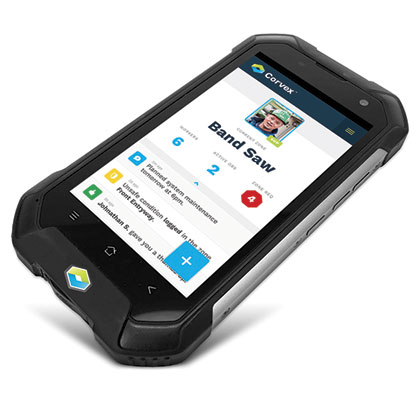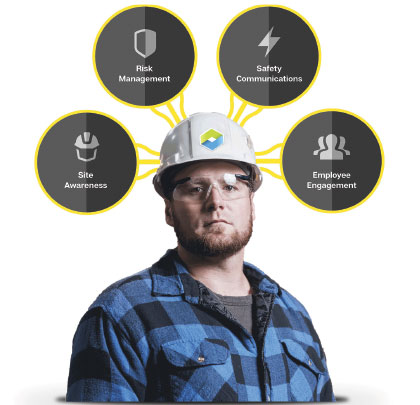We live in a connected world. Connected technology is ever-present in most of our lives today as the Internet of Things (IoT) expands. Our mobile devices are always at arm’s reach to help us navigate freeways, track our fitness and sleep, save energy at home, and provide greater organization at the office. These same technologies have the ability to make our work more productive and efficient. Communication, planning, and work processes are being transformed and optimized in many industries. Why not bring these technologies to bear for the improvement of workplace safety?
The traditional approach to safety includes hours of worker training, thousands of dollars spent on PPE, and traditional paper-based inspections and investigations. These manual safety processes for data collection and analysis have helped many companies improve their safety culture and injury experience, but the return on these safety program investments can plateau.
When safety programs rely on worker training and retraining to ensure a proactive and safe work environment, there’s an inevitable point of diminishing returns. Individual workers are limited in their capacity to predict and prevent incidents, and often have multiple concerns on their mind including safety, productivity, and quality. Introducing some smart and connected technology can bridge the improvement plateau by speeding up the process of identification of unsafe conditions and behaviors so that critical decisions can be made and executed.
WHAT DOES THIS MEAN?
Most construction workers understand the value of a safety culture and have a grasp of what safety culture excellence looks like—a jobsite where workers are on high alert of their surroundings, constantly evaluating risks for the tasks at hand, and taking precautions accordingly. In reality, jobsite supervisors are bogged down with written Job Hazard Analysis documents and most workers don’t have the tools, processes, or capacity to be as focused on jobsite safety as they are on productivity and quality.
Contractors of all sizes are recognizing the need to go beyond manual processes and adopt technologies that provide frontline workers with critical information, data, and support in a platform with the ability to communicate in real time with their team and their supervisors. Integrating this platform with PPE via wearable sensor technology makes for even more efficient data collection and seamless communication.

Featured Image: The foundational elements of the Corvex Connected Platform
Above: Corvex Core device that enables worksite awareness, risk management, safety communications, and engagement for every worker.
DATA-DRIVEN SAFETY
For decades, safety product manufacturers have improved upon safety glasses, hard hats, gloves, fall protection, and more. Smart technology and sensor integration have been deployed, but are typically product-specific with no integration with other equipment or platforms. Contractors do not find value in adopting multiple unconnected pieces of smart PPE and running as many different applications on their phone to support them. This defeats the purpose of efficient communication. The opportunity exists for a platform where these ideas and technology concepts can be unified—information sharing amongst multiple pieces of PPE with connection to larger scale corporate and jobsite data, as well as safety indicators.
Minneapolis-based Corvex Connected Safety is leading innovation on this front by developing sensor technology and an Internet of things (IoT) software platform to integrate with any PPE product and make it a smart piece of equipment. The goal of a Corvex-enabled jobsite is to create a safety community, where workers are connected with their environment, crew, and supervisors—leveraging real-time data and communication tools through the Corvex platform.
Many contractors are starting to realize the benefits of a data-driven safety community, as they’ve experienced in other areas of their business. Data produced on jobsites today is compiled manually making it difficult to manipulate for analysis and quick action. By integrating technology, companies can look forward to new efficiencies in inspection and communication by allowing team members to act on data in real time.
TRAINING ISN’T THE ONLY ANSWER
Contractors already invest in the safety of their employees through training and educational programs. An average jobsite lasts 1 to 3 years, and short of site orientation and mandated weekly or daily safety meetings, a company has little time to conduct impactful and effective safety training. Thousands to millions of dollars in safety training is spent at the corporate level with the expectation of a huge payoff by reducing or eliminating injuries. In reality, huge investments in safety education lead to a plateau of safety performance. Forward-thinking contractors now recognize that although top-down information sharing via training has its place, the focus should be on real-time information sharing in which workers take advantage of the collective knowledge and experience of their peers at the jobsite level.
RETURN ON INVESTMENT
A device on every worker equipping them with the information and technology to communicate with peers in real time can decrease costs related to time spent conducting inspections, preparing for or participating in training, and incident investigation. This decrease in costs is evidenced by more efficient worker interactions, more efficient management of safety at the jobsite, ultimately leading to reduced injuries and insurance premiums.
Employee safety is a major corporate asset that very few question the importance of investing in. The new question lies in how contractors should invest to improve safety and promote worker engagement in the most effective way possible. By integrating technology for smarter data collection, efficient communication, and real-time indicators, jobsite safety performance can benefit from a modernized approach that affects the bottom line, and more importantly—the lives of millions of workers.
INTO THE FUTURE
Technology has evolved to be extremely user-friendly to the worker, something that simply makes everyone’s daily lives work better. Our cars now have the computing power of an airplane 20 years ago, even though most drivers don’t recognize or know how the technology we have these days works. Safety, too, is a practice that makes workers lives better, so it is natural that the two practices would meld together to improve workers lives exponentially. In 20 years, we can only hope that wearing connected technology on the jobsite won’t feel unnatural, but that being on the jobsite without wearable safety tech will feel unnatural and unsafe.
About the Author:
Corvex is led by co-founders Ted Smith and Joe O’Brien, who bring together decades of experience and deep expertise in safety and enterprise software. Corvex is the first IoT solution that puts the power of connected safety in the hands of workers, creating a safer, more engaged workforce through real-time information sharing. For more information, visit www.corvexsafety.com.
_________________________________________________________________________
Modern Contractor Solutions, January 2018
Did you enjoy this article?
Subscribe to the FREE Digital Edition of Modern Contractor Solutions magazine.



